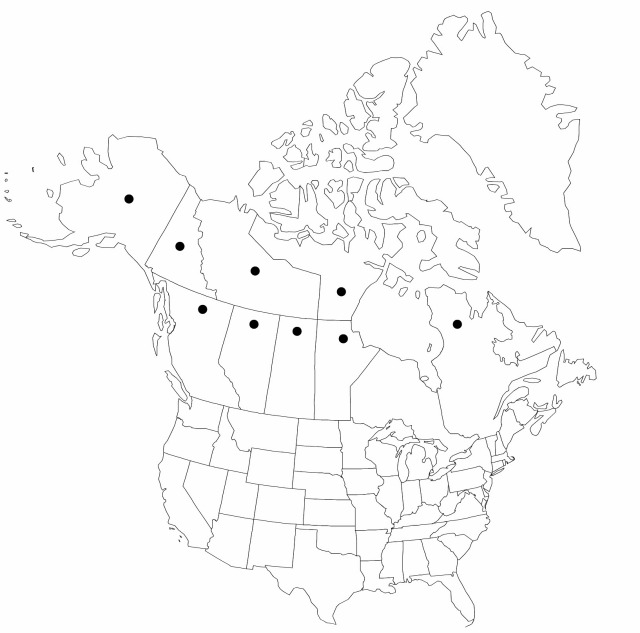Difference between revisions of "Carex lapponica"
Linnaea 24: 539. 1851.
FNA>Volume Importer |
imported>Volume Importer |
||
| (6 intermediate revisions by 2 users not shown) | |||
| Line 8: | Line 8: | ||
}} | }} | ||
|common_names=Carex de Laponie | |common_names=Carex de Laponie | ||
| + | |special_status={{Treatment/ID/Special_status | ||
| + | |code=F | ||
| + | |label=Illustrated | ||
| + | }} | ||
|basionyms= | |basionyms= | ||
|synonyms={{Treatment/ID/Synonym | |synonyms={{Treatment/ID/Synonym | ||
|name=Carex canescens var. subloliacea | |name=Carex canescens var. subloliacea | ||
|authority=Laestadius | |authority=Laestadius | ||
| + | |rank=variety | ||
}} | }} | ||
|hierarchy=Cyperaceae;Carex;Carex sect. Glareosae;Carex lapponica | |hierarchy=Cyperaceae;Carex;Carex sect. Glareosae;Carex lapponica | ||
| Line 27: | Line 32: | ||
|elevation=0–200 m | |elevation=0–200 m | ||
|distribution=Alta.;B.C.;Man.;N.W.T.;Que.;Sask.;Yukon;Alaska;n Eurasia. | |distribution=Alta.;B.C.;Man.;N.W.T.;Que.;Sask.;Yukon;Alaska;n Eurasia. | ||
| − | |discussion=<p>Carex lapponica is probably an often overlooked species in the flora area.</p> | + | |discussion=<p><i>Carex lapponica</i> is probably an often overlooked species in the flora area.</p> |
|tables= | |tables= | ||
|references= | |references= | ||
| Line 36: | Line 41: | ||
-->{{#Taxon: | -->{{#Taxon: | ||
name=Carex lapponica | name=Carex lapponica | ||
| − | |||
|authority=O. Lang | |authority=O. Lang | ||
|rank=species | |rank=species | ||
| Line 50: | Line 54: | ||
|publication title=Linnaea | |publication title=Linnaea | ||
|publication year=1851 | |publication year=1851 | ||
| − | |special status= | + | |special status=Illustrated |
| − | |source xml=https:// | + | |source xml=https://bitbucket.org/aafc-mbb/fna-data-curation/src/2e0870ddd59836b60bcf96646a41e87ea5a5943a/coarse_grained_fna_xml/V23/V23_560.xml |
|genus=Carex | |genus=Carex | ||
|section=Carex sect. Glareosae | |section=Carex sect. Glareosae | ||
Latest revision as of 20:41, 5 November 2020
Plants densely cespitose, in small clumps; rhizomes short. Culms erect, relatively strict, 15–40 cm. Leaves: sheaths relatively tight, pale brown abaxially, inner band thin, hyaline, concave at summit; ligules as wide as long; blades pale green to gray-green, flat, 10–20 cm × 1–2 mm, subequal to or shorter than culms, papillose, densely so abaxially. Inflorescences 1.5–4 cm × 4–5 mm; proximal bracts shorter than to exceeding spikes, distal bracts usually scalelike. Spikes 3–6(–7), gynecandrous, proximal sometimes remote, distal approximate, containing 10–20 perigynia, suborbicular to ovoid, 3–7 × 3–5 mm; terminal spike staminate for 1/2 length, not or scarely clavate. Pistillate scales hyaline with green, 3-veined center when young, usually brownish tinged in age, broadly ovate, subequal to, not concealing perigynia, apex obtuse to acutish. Perigynia appressed-ascending, gray-green, becoming pale brown in age, obscurely many-veined on both faces, elliptic-ovate, 1.8–2.1 × 1–1.3 mm, widest near middle, membranous; beak short, entire. Achenes yellowish brown, oblong-obovate, 1.25 × 1 mm, dull to slightly glossy. 2n = 56.
Phenology: Fruiting early summer.
Habitat: Sphagnum bogs, wet, nutrient-poor areas, mostly lowlands
Elevation: 0–200 m
Distribution

Alta., B.C., Man., N.W.T., Que., Sask., Yukon, Alaska, n Eurasia.
Discussion
Carex lapponica is probably an often overlooked species in the flora area.
Selected References
None.
